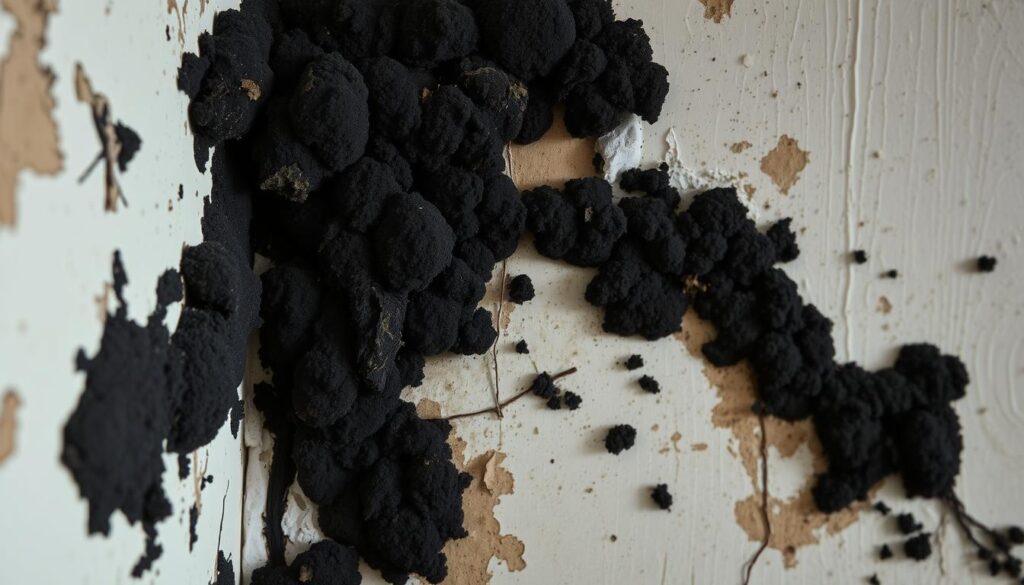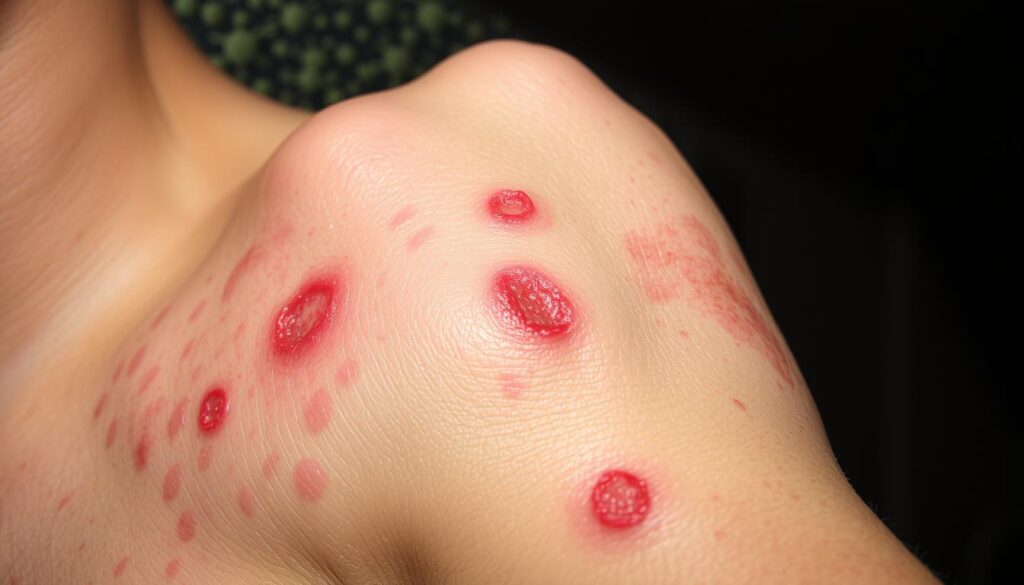Did you know toxic mold is a big health worry in Australia? It’s found in about 1 in 6 homes. These hidden enemies can cause serious health problems, like breathing issues and brain damage. As a homeowner, knowing the signs of mold is key.
In this guide, we’ll look at the top 10 signs of toxic mold. These signs can help you protect your family’s health. From breathing problems to brain changes, spotting these signs early can stop mold issues before they get worse.
Key Takeaways
- Toxic mold exposure is a serious health concern affecting many Australian homes.
- Early detection of mold symptoms is crucial for effective remediation and prevention.
- Common signs of mold exposure include respiratory issues, neurological changes, and skin reactions.
- Recognising these symptoms can help you address mold problems before they worsen.
- Seeking medical advice and professional mold inspection are recommended if you suspect a problem.
Understanding Toxic Mold and Its Impact on Health
Mold is a common problem in Australian homes. Some species produce toxic substances called mycotoxins. These can harm human health, causing symptoms and long-term health problems. It’s important to know about the types of toxic mold, how it affects the body, and who is at risk.
Types of Toxic Mold in Australian Homes
In Australian homes, especially in damp or humid areas, certain toxic mold species thrive. These include Aspergillus, Penicillium, and Stachybotrys. These molds can produce mycotoxins that harm human health. Knowing about these molds helps us understand and tackle the risks of mycotoxin exposure.
How Mold Affects the Human Body
Being exposed to toxic mold can cause health issues. These range from breathing problems to neurological symptoms. Mycotoxins can cause inflammation, weaken the immune system, and affect energy production. This can lead to mold allergy signs and chronic toxic mold illness.
Risk Factors for Mold Exposure
- Increased humidity or moisture in the home
- Preexisting respiratory conditions, such as asthma or allergies
- Weakened immune system due to factors like age, illness, or medications
- Genetic predisposition to mold sensitivity
- Proximity to construction or renovation sites
Knowing these risk factors helps us prevent and address mold-related health issues in our homes.
Respiratory Issues: Primary Indicators of Mold Presence
Respiratory symptoms are often the first signs of mold exposure. These can include coughing, wheezing, and breathing difficulties. It’s important to understand how mold affects our breathing to tackle the problem effectively.
Mold can lead to various respiratory problems, such as:
- Chronic coughing and wheezing
- Difficulty breathing or shortness of breath
- Chest tightness or discomfort
- Increased susceptibility to respiratory infections
- Exacerbation of asthma symptoms
The body reacts to mold toxins and allergens by causing inflammation. This is why treating mold exposure and improving indoor air quality are key. Testing the air indoors can help find and fix the mold problem.
“Respiratory symptoms are often the first and most noticeable sign that mold may be present in the home or workplace. Addressing these issues promptly is crucial for maintaining long-term health and wellbeing.”
Knowing the link between respiratory issues and mold helps us protect our health. We can make our living or work spaces safer and healthier by acting on this knowledge.

Signs of Toxic Mold Exposure in Daily Life
Being exposed to black mold can harm your health. It can cause immediate symptoms and long-term effects. Knowing these signs is important to keep you safe.
Immediate Symptoms to Notice
Exposure to black mold can lead to several symptoms right away, including:
- Respiratory issues, such as coughing, sneezing, and trouble breathing
- Headaches, dizziness, and feeling very tired
- Skin problems, like rashes or eczema
- Nasal congestion, sinus issues, and eye irritation
Long-term Health Effects
Long-term exposure to mold can cause serious health problems, such as:
- Neurological issues, like memory loss, trouble thinking, and mood swings
- Digestive problems, including nausea, vomiting, and stomach pain
- Joint pain, inflammation, and autoimmune diseases
- Chronic respiratory conditions, like asthma and lung scarring
When to Seek Medical Help
If you think you’re showing symptoms from mold exposure, get medical help fast. A doctor can check you, figure out what’s wrong, and suggest treatments. This can help fix the mold-related health issues.

Acting quickly is important to reduce the harm from mold and protect your health.
Neurological Symptoms and Cognitive Changes
Being exposed to toxic mold can harm the nervous system. It can cause a variety of symptoms and changes in how we think. These issues can really affect someone’s life quality.
One common symptom is headaches. Mycotoxins from mold can cause brain inflammation. This leads to severe migraines or tension headaches. These headaches can be hard to treat and may last a long time.
Mold exposure can also mess with memory and thinking skills. Mycotoxins can disrupt brain function. This affects memory, focus, and solving problems. People exposed to mold for a long time might struggle to remember things, make decisions, or do everyday tasks.
Mood swings are another symptom of mold exposure. Mycotoxins can mess with neurotransmitters. This can cause mood swings, anxiety, and depression. People exposed to toxic mold might feel irritable, anxious, or tired a lot.
It’s important to understand how mold affects the brain. If you think you’re affected, see a doctor right away. Fixing the mold problem is key to avoiding long-term brain and emotional damage.

| Neurological Symptom | Potential Impact |
|---|---|
| Headaches | Debilitating migraines or tension-type headaches |
| Memory Problems | Difficulties with recalling information, decision-making, and completing tasks |
| Mood Changes | Irritability, anxiety, depression, and lethargy |
Skin Reactions and Allergic Responses
Being around toxic mold can cause skin problems like rashes and hives. It can also lead to severe allergic reactions. It’s important to know how mold affects the skin and how it’s different from other allergies.
Common Skin Manifestations
Rashes and hives are common skin reactions to toxic mold. These can be itchy and unsightly. They happen when the body reacts to mold spores or mycotoxins.
Some people might also get eczema. This is a long-term skin problem that can get worse with mold exposure.
Distinguishing Mold Allergies from Other Allergies
It can be hard to tell if a skin reaction is from mold or another allergy. But, there are clues. Mold allergies often show up more in damp or humid weather. This is because mold grows well in these conditions.
Also, mold allergy symptoms can be more serious and last longer. This is different from other environmental allergies.
The idea of sick building syndrome is connected to poor indoor air quality. This includes black mold. When mold is in a building, it can cause many health issues. Skin problems are one of them.

“Mold exposure can have a significant impact on the skin, leading to a range of unsightly and potentially debilitating conditions. Understanding the unique characteristics of mold-related skin issues is crucial for effective diagnosis and treatment.”
Digestive System Disruptions and Related Issues
Toxic mold can harm your digestive system, causing many unpleasant symptoms. These include nausea, vomiting, abdominal pain, and diarrhea. The effects on your gut can be both immediate and long-lasting.
Mold can disrupt your digestive system by producing mycotoxins. These toxic compounds can upset the balance of your gut microbiome. They can also cause inflammation in your gastrointestinal tract.
Long-term exposure to mold can lead to chronic problems. These include malabsorption of nutrients and leaky gut syndrome. Such conditions can cause nutrient deficiencies, food sensitivities, and autoimmune disorders.
If you think mold is affecting your digestion, see a doctor quickly. A healthcare professional can find the cause of your symptoms. They will then create a treatment plan to fix the problem.
“Digestive issues are one of the most common and debilitating symptoms of mold exposure. It’s crucial to address these problems head-on to protect your long-term health.”
Recognizing mold toxicity signs and acting on them is key to your health. Being vigilant and getting the right medical help can help you regain control. This puts you on the path to a healthier future.
Sleep Disturbances and Fatigue Patterns
Toxic mould can badly affect how well you sleep and how much energy you have. The presence of sick building syndrome or poor indoor air quality can cause sleep problems. This leads to a cycle of poor sleep and black mold health effects.
Impact on Sleep Quality
Mould spores and VOCs can cause breathing issues, allergies, and inflammation. These problems can mess up your sleep patterns. People exposed to mould might find it hard to fall asleep, wake up a lot, and not get deep, restful sleep.
Connection Between Mold and Chronic Fatigue
- Long-term mould exposure is linked to chronic fatigue syndrome (CFS). This is a serious condition with ongoing tiredness, brain fog, and less physical strength.
- The toxins from some moulds might harm your brain and immune system. This can lead to chronic fatigue and feeling unwell.
- People with CFS are often more sensitive to things like mould. This can make their symptoms worse and slow down their recovery.
Fixing sick building syndrome and improving indoor air quality are key to managing mould-related sleep and fatigue issues. Getting help from experts and using effective cleaning methods can help improve your health and well-being.
Eye and Vision Problems Associated with Mold
Being around toxic mold can really hurt your eyes and vision. Mold spores and mycotoxins from black mold can make your eyes red, itchy, and blurry. These eye problems are often the first sign of bigger health issues from mold exposure.
Mold symptoms often start with eye troubles. The harmful chemicals from mold can get into your eyes, causing swelling and pain. Long-term exposure might lead to serious vision problems, like trouble seeing colours and being too sensitive to light.
- Redness and irritation in the eyes
- Itchiness and a burning sensation
- Blurred or cloudy vision
- Increased sensitivity to light
- Difficulty with colour perception
It’s key to deal with these eye and vision issues quickly. They might show signs of black mold health risks and mycotoxin exposure. Not treating these symptoms can cause bigger problems, making it vital to tackle mold early and get medical help when needed.
“Mold exposure can have a profound impact on the eyes, often serving as an early warning sign of broader health issues. Addressing these visual symptoms is crucial for safeguarding one’s overall wellbeing.”
Joint Pain and Inflammatory Responses
Being exposed to toxic mould can harm our health in many ways. It’s not just about breathing problems and brain fog. It can also cause joint pain and inflammation.
Understanding Inflammation from Mold
When we’re exposed to toxic mould, our body reacts with inflammation. This leads to swelling, stiffness, and pain in our joints. It’s like our body is fighting off the mould toxins.
But, if we’re exposed for a long time, it can cause chronic inflammation. This means ongoing joint pain and might even damage our tissues.
Treatment Options for Joint Issues
Fixing joint pain and inflammation from toxic mold illness needs a few steps. First, we must find and fix the mould problem. This might mean mould remediation and looking into mold exposure treatment to help our body heal.
Then, we can use anti-inflammatory meds, supplements, and change our lifestyle. Some good treatments include:
- Non-steroidal anti-inflammatory drugs (NSAIDs) to reduce inflammation
- Omega-3 fatty acid supplements to help regulate the body’s inflammatory response
- Regular exercise and physical therapy to improve joint mobility and strength
- Stress management techniques, such as meditation or yoga, to reduce overall inflammation
By tackling the toxic mold illness and using the right treatments, we can ease joint pain and inflammation caused by mould.
Conclusion
In this article, we’ve looked at the signs and symptoms of toxic mold exposure. These include respiratory issues, neurological changes, skin reactions, and digestive problems. It’s important for people in Australia to watch out for black mold and other harmful fungi in their homes.
Knowing the early signs of mold, like coughing, skin rashes, and feeling tired, helps you act fast. This way, you can protect your health. Always pay attention to any changes in your health that might mean you have a mold problem. Then, get help from experts who can find and fix the mold.
Keeping your home free from mold is key to your family’s health. By knowing the signs of toxic mold and acting quickly, you can avoid serious health issues. Your careful watch and quick action are the best ways to fight off toxic mold.





